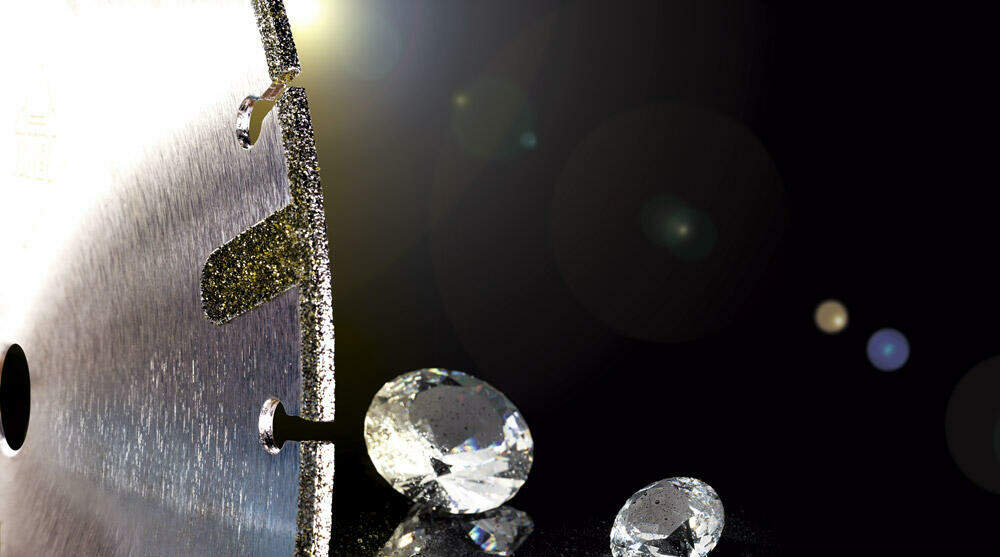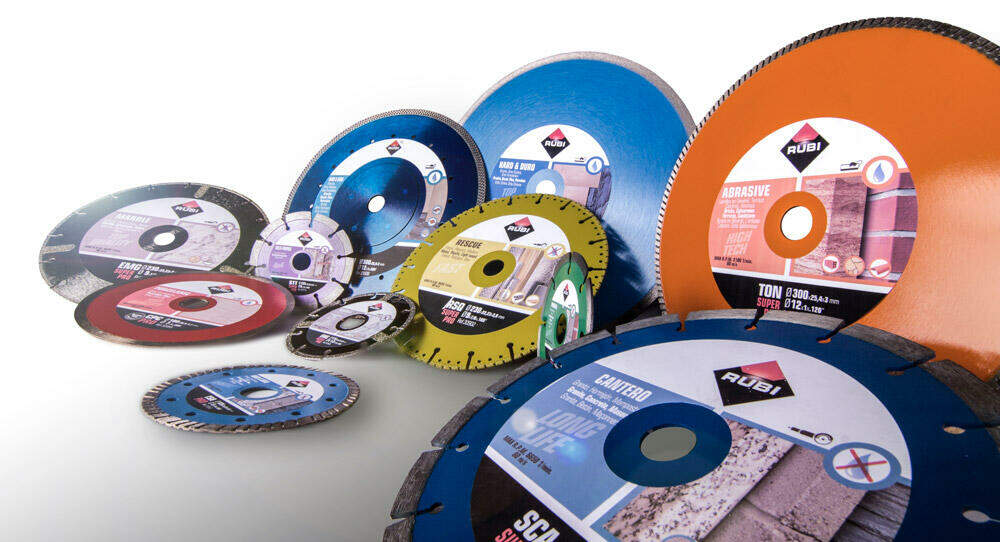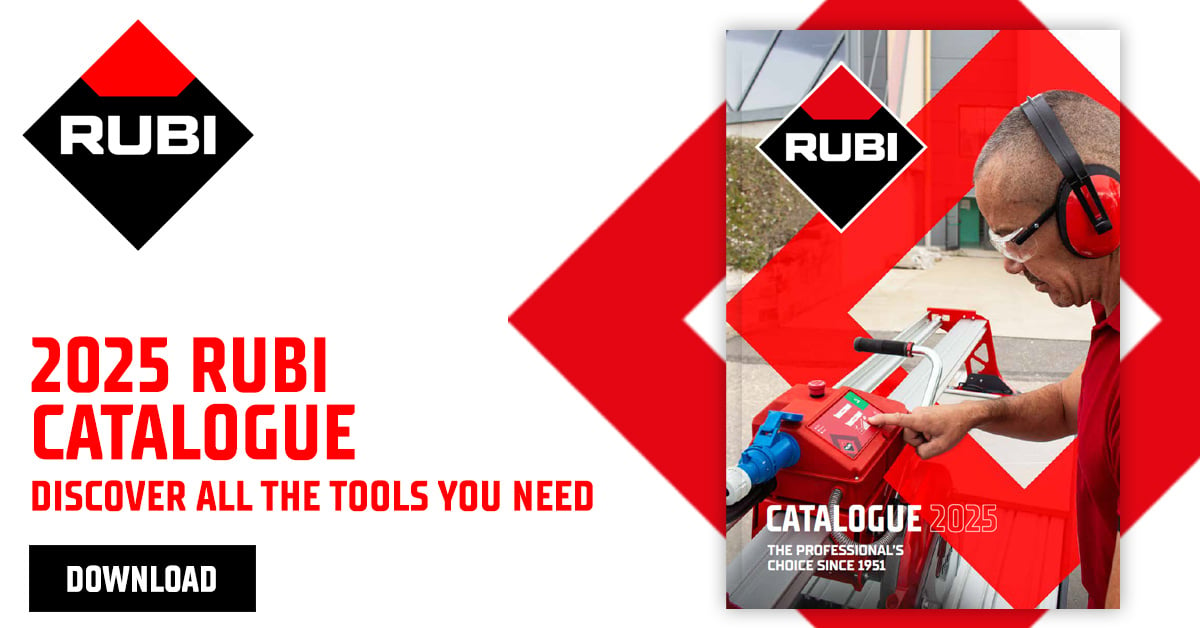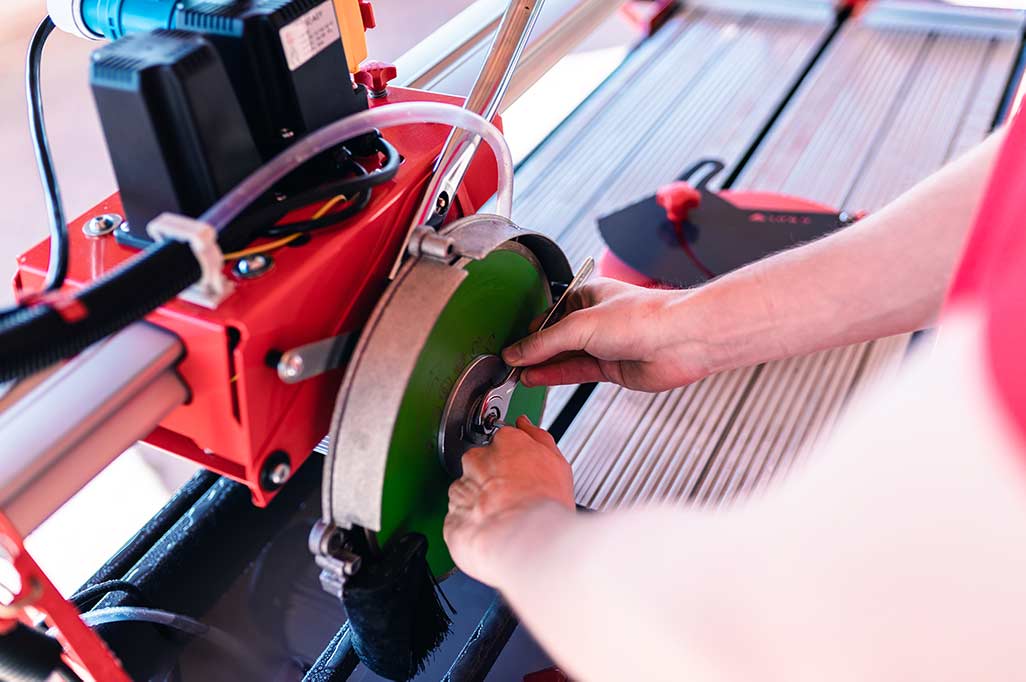There are specific blades for cutting different types of tile. But talking about diamond blades and which one is the most appropriate for cutting a type of material really depends a lot on our cutting needs.
In todays’ how to tile blog, we look at diamond blades. Knowing how the blades work and how they are created will help us to better understand what type of tile cutting disc we need or which one is the best for cutting our type of tile or the material.


WHAT ARE DIAMOND BLADES?
Diamond blades are a super-abrasive and are made up of a circular body, mostly made of steel, called “core”. The core has on its periphery the cutting material in the form of a continuous crown or in segments. This cutting material, which we call the diamond band, can be joined to the disc core in different ways, but the most commonly used by RUBI is laser welding.
DIAMOND GRAINS
The diamond grains can be attached to the discs in 3 different ways, which are sintering, electroplating and vacuum brazing. But in the case of specific discs for cutting ceramics, we will normally be talking about sintering.
In the sintering process, the diamond particles are mixed with the metal binder and consolidated by pressure and temperature, creating a system with different layers of diamond that are exposed as the tool wears.
RELATIONSHIP BETWEEN GRIT SIZE, BOND CONCENTRATION & BOND HARDNESS
The relationship between diamond grit size, grit concentration and bond hardness varies depending on the requirements of the blade.
- For hard materials, we use a small grit type with a high diamond concentration and a soft bond.
- For abrasive materials, we use a large grit size with a low diamond concentration and a hard bond.
- If we cut all types of materials, we use a large grit size, a low diamond concentration and a soft bond.
Ideally, both should be worn at the same time. If we have a soft bond, the metal will wear away and the diamond will always come to the surface so that we can cut efficiently, but the life of the blade will be affected especially when cutting abrasive materials.
On the other hand, if the bond is too hard, the diamond will wear out without being replaced because the bond does not wear out at the same time and the tool will lose its cutting effectiveness. When this occurs, the blade is classed as ‘dull’.
To solve this problem, we can use a cleaning block, which is a super-abrasive block material that will wear away the bond of the blade and bring out the diamond particles from the lower layers.
TYPES OF SINTERED DIAMOND BLADES
The types of sintered blades are:
- Continuous strip: Provides the best finish. Used for cutting and mitring ceramic or other stone facing materials, with thickness <25 mm.
- Turbo: A great combination. High performance and cutting speed with high quality finishes.
- Viper: It is the evolution of the TURBO blade with a higher quality and speed. It is totally indicated for high hardness materials.
- Segmented: The fastest. Maximum speed and better cooling of the blade. For cutting materials >25 mm thick.
- Turbo segmented: For cutting all types of materials at maximum speed.
- J-Slot: State-of-the-art technology. High speed on the hardest materials. Specially designed for straight cutting of porcelain stoneware. Eliminates the tensions generated during cutting.
The higher the cutting speed, the lower the quality and vice versa. The discs with the most balanced speed-quality ratio are the turbo and viper type.
In this video you can see the CEV-SUPERPRO 250mm diamond blade working on a RUBI DC250-850.

HOW TO CHOOSE THE RIGHT DIAMOND BLADE?
Now that we know how the blades work, how they are created, the types and their characteristics, we must take into account 3 aspects when choosing a diamond blade:
1. What type of cutting we are going to do
Depending on the type of cutting we are going to do, we must think about what type of machine we are going to use: an electric machine, a grinder? And consequently, what type of cooling we are going to have.
We have to bear in mind that discs cut by friction and that they are super-abrasive tools. This friction generates high temperatures during cutting and this gives rise to 2 types of cutting: wet cutting and dry cutting.
In dry cutting, the only cooling is provided by the ventilation generated by the rotating blade itself. Dry cutting discs can be cooled with water for greater durability and a better finish, but wet cutting discs should never be used without water.
At RUBI we have cutting discs for both dry and wet cutting. So before deciding, we must know which machine we are going to use and the type of cooling.
2. Types of materials we need to cut
The 2nd thing we have to take into account is what kind of materials we are going to cut.
When we talk about cutting ceramic tile materials, both fall into the group of siliceous materials. These materials, which are mainly composed of silica, have a medium-high hardness, although some can also have very high levels of abrasiveness.
Among the most common siliceous materials is the group we are interested in: ceramic materials such as tiles, glazed stoneware or porcelain stoneware. Glass and granite are also included in this group.
Therefore, due to the hardness of these materials, we will need a combination of small grit, with a high concentration of diamond and a soft bond, which wears at the same time as the diamond to avoid blunting of the disc and to have a good performance of the tool.
3. Cutting speed vs. finish quality
The 3rd aspect to consider is whether we need cutting speed or finishing quality.
This will depend on the type of cut we are going to make. It is not the same to make a straight or diagonal cut, where we may need speed, as it is to make a mitre cut where we will need precision and finishing quality.
Not all discs are suitable for all types of cutting. For mitre or miter cutting, we need blades with sufficient reinforcement and core thickness to withstand the 45º cut without breaking. The minimum core thickness for mitre cutting varies depending on the diameter of the blade.
In short, we must take into consideration whether we are going to do wet or dry cutting (depending on the machine we will use), the hardness properties of a material such as ceramic, and whether we need cutting speed or quality finishes.
Once we know this, we are now ready to choose the best blade for cutting our tiles.
Range of RUBI Diamond Blades
From the range of RUBI diamond blades, we can highlight the following:
For dry cutting:
- CPR: Continuous disc, recommended for fine cutting of porcelain stoneware with a thickness of less than 20 mm. It provides one of the best finishes. Available in diameters of 115 and 125 mm.
- TCR: Turbo type disc, recommended for fine cutting of porcelain stoneware with high performance and cutting speed with high quality finishes. Available in diameters of 115 – 125 – 180 – 230 mm.
- CPJ: J-Slot type disc, increases cutting speed on very hard porcelain stoneware tiles, while reducing the stresses generated during cutting. Available in 115 and 125 mm diameters.
For wet cutting:
- CPC: Continuous disc, recommended for fine cutting of porcelain stoneware tiles with thicknesses of less than 20 mm. Especially recommended for mitre cutting. Available in diameters of 180 – 200 – 230 – 250 – 300 – 350 mm.
- CPX: J-Slot type disc, with state-of-the-art technology for high speed straight cutting of porcelain stoneware. Available in diameters of 200 – 250 – 300 mm.
- TPI: Turbo type disc, recommended for mitre cutting of porcelain stoneware. Provides high stability and cutting speed. Available in diameters of 200 – 230 – 250 mm.

Colour classification of RUBI diamond blades
As well as the blades listed above, at RUBI we have many other models of discs for your cutting preferences. Therefore, to make it easier for you to choose, we use a colour classification to make your choice easier. Each colour tells us what use or application the disc is originally designed for:
Red: suitable if we mainly want to cut porcelain
Violet and dark green: for discs that cut general building materials.
Green: for general ceramic material
Blue: for hard materials
Orange: for abrasives
Grey: for marble
Yellow: for rescue
We hope that now that you know all this, it will be easier for you to choose the best disc for cutting ceramics.
For more tiling tips and tricks on how to tile, please check out more of our blog articles here.



Post a comment